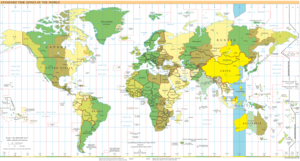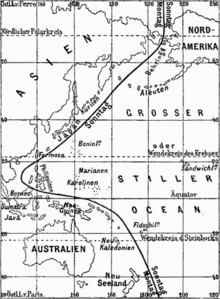Philippine Standard Time
| Philippine Standard Time | |
|---|---|
| Time zone | |
The Clock tower of Manila City Hall is the icon for synchronizing the time in the whole Philippine archipelago, before an atomic clock was introduced in the country in 2012. The purposes of these Philippine "towering timepieces" are to tell the time and to serve as landmarks. | |
| UTC offset | |
| PHT | UTC+08:00 |
| Current time | |
| 01:39, 2 January 2025 PHT [refresh] | |
| Observance of DST | |
| DST is not observed in this time zone. | |
Philippine Standard Time (PST[1][2] or PhST;[3][4] Filipino: Pamantayang Oras ng Pilipinas), also known as Philippine Time (PHT),[citation needed] is the official name for the time zone used in the Philippines. The country only uses a single time zone, at an offset of UTC+08:00, but has used daylight saving time for brief periods in the 20th century until July 28, 1990.
Geographic details
[edit]
Geographically, the Philippines lies within 116°53′[clarification needed] and 126°34′[clarification needed] east of the Prime Meridian,[5] and is physically located within the UTC+08:00 time zone. Philippine Standard Time is maintained by the Philippine Atmospheric, Geophysical and Astronomical Services Administration (PAGASA). The Philippines shares the same time zone with China, Taiwan, Hong Kong, Macau, Malaysia, Singapore, Western Australia, Brunei, Irkutsk (Russia), Central Indonesia, and most of Mongolia.
History
[edit]
For 323 years, 9 months, and 14 days,[note 1] which lasted from Saturday, March 16, 1521 (Julian Calendar), until Monday, December 30, 1844 (Gregorian Calendar), the Philippines followed the date of the western hemisphere and had the same date as Mexico. This was because it was a Spanish colony supplied and controlled via Mexico until Mexico's independence on September 27, 1821. On August 16, 1844, the Spanish Governor-General Narciso Claveria decreed that Tuesday, December 31, 1844, should be removed from the Philippine calendar. Monday, December 30, 1844, was immediately followed by Wednesday, January 1, 1845, which added 1 day or 24 hours to the local time. This change meant that the International Date Line moved from going west of the Philippines to go on the east side of the country, which had to follow the eastern hemisphere to align itself with the rest of Asia.[6][7] At the time, local mean time was used to set clocks, meaning that every place used its own local time based on its longitude because the time was measured by locally observing the Sun.
Philippine Standard Time was instituted through Batas Pambansa Blg. 8 (that defined the metric system), approved on December 2, 1978, and implemented on January 1, 1983. The Philippines is one of the few countries to officially and almost exclusively use the 12-hour clock in non-military situations.[note 2][citation needed][dubious – discuss]
In September 2011, the Department of Science and Technology proposed to synchronize time nationwide, which was an effort to discourage tardiness and non-standard time displayed on television and radio stations. PAGASA installed a rubidium atomic clock, a GPS receiver, a time interval counter, a distribution amplifier, and a computer to help calculate the time difference with every satellite within its antenna's field of view.[8][9]
In order to promote synchronicity with official time, on May 15, 2013, President Benigno Aquino III signed Republic Act No. 10535 setting the Philippine Standard Time,[10] requiring all government offices and media networks to synchronize their timepieces with PAGASA's rubidium atomic clock.[11][12]
Time in the Philippines
[edit]| Period in use | Time offset from GMT/UTC | Name of time |
|---|---|---|
| Saturday, March 16, 1521 (Julian Calendar) – Monday, December 30, 1844 (Gregorian Calendar) | GMT−15:56 (in Manila) | local mean time |
| GMT−16:12 (in Balabac, the westernmost island) | ||
| GMT−15:34 (in Davao Oriental, the easternmost area) | ||
| The day that never occurred as ordered by the Spanish Governor-General Narciso Claveria to add 24 hours to the local mean time.[13] | Time Zone change[note 3] | |
| Wednesday, January 1, 1845 – May 10, 1899 | GMT+08:04 (in Manila) | local mean time |
| GMT+07:48 (in Balabac, the westernmost island) | ||
| GMT+08:26 (in Davao Oriental, the easternmost area) | ||
| May 11, 1899 – October 31, 1936 | GMT+08:00 | Philippine Standard Time |
| November 1, 1936 – January 31, 1937 | GMT+09:00 | Philippine Daylight Saving Time |
| February 1, 1937 – April 30, 1942 | GMT+08:00 | Philippine Standard Time |
| May 1, 1942 – October 31, 1944 | GMT+09:00 | Tokyo Standard Time[note 4] |
| November 1, 1944 – April 11, 1954 | GMT+08:00 | Philippine Standard Time |
| April 12, 1954 – June 30, 1954 | GMT+09:00 | Philippine Daylight Saving Time |
| July 1, 1954 – March 21, 1978 | GMT/UTC+08:00 | Philippine Standard Time |
| March 22, 1978 – September 20, 1978 | UTC+09:00 | Philippine Daylight Saving Time |
| September 21, 1978 – May 20, 1990 | UTC+08:00 | Philippine Standard Time |
| May 21, 1990 – July 28, 1990 | UTC+09:00 | Philippine Daylight Saving Time |
| July 29, 1990 – present | UTC+08:00 | Philippine Standard Time |
Use of daylight saving time
[edit]Since 1990, the Philippines has not observed daylight saving time, although it was in use for short periods during the presidency of Manuel L. Quezon in 1936–1937, Ramon Magsaysay in 1954, Ferdinand Marcos Sr. in 1978, and Corazon Aquino in 1990.[14]
IANA time zone database
[edit]The IANA time zone database contains one zone for the Philippines in the file zone.tab, named Asia/Manila
Date and time format
[edit]Date
[edit]- Standard: August 18, 2023 (month day, year or mm/dd/yyyy)
- Formal (Public Documents): the 18th day of August, 2023 or 18 August 2023 (day month year)
- Filipino: ika-18 ng Agosto, 2023 or 18 Agosto 2023 (dd-mm-yyyy)
- Passport: 18 08 2023 (dd mm yyyy)
Time
[edit]- Standard: 12-hour clock
- Military/Scouting: US Military Time
- Public Transport and Marathon events: 24-hour clock
- Common Spoken Language
- Tagalized Spanish terminology (original Spanish spelling in parentheses; AM radio stations and everyday conversation)
- 8:41 – Alas otso kuwarenta y uno (A las ocho cuarenta y uno)
- 5:30 – Alas singko y medya (A las cinco y media)
- 3:00 – Alas tres (A las tres; en punto, literally meaning "on the dot", may be added to signify "o'Clock".)
- English (Business, Legal and others)
- 8:41 PM – Eight forty-one PM
- 5:30 AM – Five Thirty AM
- 3:00 PM – Three O'Clock or Three PM
- 12:00 PM – Twelve Midday or Twelve Noon – Twelve PM is seldom used as it might be confused with 12 Midnight
- 12:00 AM – Twelve Midnight – Twelve AM is seldom used as it might be confused with 12 Noon
- Tagalog and Filipino
- Starts with Spanish-derived (original spelling in parentheses) and ends with Tagalog – Umaga starts at 5:00 AM and ends 11:59 AM. Tanghalì is noon. Hapon starts at 1:00 PM and ends 5:59 PM. Gabí starts at 6:00 PM and ends 12:00 AM which is Hatinggabi. Madalíng Araw starts at 12:01 AM and ends 4:59 AM. Except in very formal situations, Filipinos rarely use the vernacular numbers in telling time.
- 8:41 P.M. – Alas otso kuwarenta y uno (A las ocho cuarenta y uno) ng gabí or Apatnapú't-isá(ng minuto) makalipas ng ikawaló ng gabí or (ika)waló at apatnapú't-isá (na) ng gabi
- 5:30 A.M. – Alas singko y medya (A las cinco y media) ng umaga or Tatlumpû(ng minuto) makalipas ng ikalimá ng umaga or Kalahati makalipas ng ikalimá ng umaga or (ika)limá at kalaháti ng umaga or (ika)limá at tatlumpû(ng minuto) (na) ng umaga
- 3:00 P.M. – Alas tres (A las tres) ng hapon o Ikatló ng hapon
- 12:00 P.M. – Alas dose (A las doce) ng tanghalì o Ikalabíndalawá ng tanghalì
- 12:00 A.M. – Alas dose (A las doce) ng hatinggabi o Ikalabíndalawá ng hatinggabí
- 2:00 A.M. – Alas dos ng madalíng araw (A las dos) o Ikalawá ng madalíng araw
- Tagalized Spanish terminology (original Spanish spelling in parentheses; AM radio stations and everyday conversation)
Notes
[edit]- ^ Within the Papal Bull of Pope Gregory XIII that mandated the introduction of the Gregorian calendar in 1582. Italy, Portugal, and Spain (including its overseas possessions like the Philippines, and the Americas) skipped 10 days to make the process of a calendrical switch from the Julian to the Gregorian calendar. Thursday, October 4, was followed by Friday, October 15, 1582. Because the Julian calendar acknowledged a leap year day and the Gregorian calendar did not during centennial years (ending with “00”), the Julian calendar fell one day further behind, bringing the difference to 11 days from March 1 (O.S. February 19), 1700 until February 28 (O.S. February 17), 1800, and another one day to 12 days from March 1 (O.S. February 18), 1800 to February 28 (O.S. February 16), 1900; the count of excess days became considered as only 4 instead of 14, to acknowledge the 10 days that the Philippines lose during the period when it was using the American date.
- ^ Aside from the 12-hour clock, the Philippines also uses 24-hour clock format as the personal preference of some Filipino people. Smartwatches sold in the Philippines are programmed to display a 24-hour clock as a default function. Even smartphones, laptops, or personal computers can be set to a 12-hour clock format also being programmed to 24 as what they preferred to use. But still pronounced as 12-hour orally.
- ^ The change also applied to Caroline Islands, Guam, Marianas Islands, Marshall Islands and Palau for being part of the Captaincy General of the Philippines during that time.
- ^ During World War II, the Philippines became under the control of Imperial Japan following the "Fall of Manila" on January 2, 1942, caused by the invasion of the Imperial Japanese Army. However, Japan was defeated by the United States Navy at the Battle of Leyte Gulf and then liberated Visayas on October 26, 1944. After a few days, the clocks set back to Philippine Standard Time.
See also
[edit]References
[edit]- ^ "Republic Act No. 10535, The Philippine Standard Time (PST) Act of 2013". Official Gazette of the Republic of the Philippines. May 15, 2013.
- ^ Medina, Marielle (January 4, 2017). "National Time Consciousness Week". Philippine Daily Inquirer. Inquirer Research. Retrieved January 6, 2018.
- ^ Lacanilao, Arianne (January 5, 2018). "DOST urges Pinoys to follow PH Standard Time". Philippine News Agency. Philippine Canadian Inquirer. Archived from the original on January 6, 2018. Retrieved January 6, 2018.
- ^ "Philippine Standard Time".
- ^ "Republic Act No. 9522". Official Gazette of the Republic of the Philippines. Archived from the original on August 14, 2018. Retrieved February 13, 2022.
- ^ R. H. van Gent. "A History of the International Date Line". Webspace.science.uu.nl. Retrieved December 30, 2011.
- ^ Tantiangco, Aya (January 1, 2017). "Philippines skipped New Year's Eve and lost a day in 1844". gmanetwork.com. GMA News Online. Retrieved April 15, 2023.
- ^ Pedrasa, Ira (September 26, 2011). "Juan Time: Filipino time redefined". ABS-CBN News.
- ^ "Clocks and countdowns set for 'Juan Time'". Philippine Daily Inquirer. December 31, 2011. Archived from the original on January 6, 2018.
- ^ Republic Act No. 10535 (May 15, 2013), "The Philippine Standard Time (PST) Act of 2013", Official Gazette of the Republic of the Philippines, archived from the original on July 3, 2017
- ^ "PHL Standard Time to counter 'Filipino time' starting June 1". GMA News. May 25, 2013.
- ^ Are you on Philippine Standard Time? | ABS-CBN News
- ^ Joel (August 27, 2007). "Missing date in Philippines history: 31 December 1844". wordpress.com. Far Outliers. Retrieved March 7, 2022.
- ^ "Daylight saving time dates for Manila, Philippines between 2000 and 2009". timeanddate.com.
